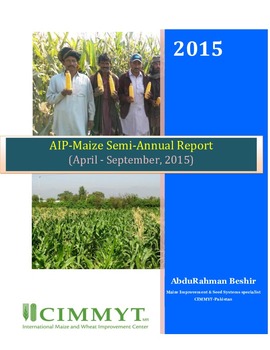AIP-Maize Semi-Annual Report: (April - September, 2015)
Abstract
Maize is Pakistan’s third most important cereal crop covering an annual area of 1.17 million hectares. Maize in Pakistan is showing an increasing trend both in area and productivity. In 2013/14, maize showed a 45% production increase from its levels during 2005-06 (PBS, 2014). Although the demand for feed is the main reason behind the upsurge of maize production, however, population increase and price hikes for other crops makes maize as a preferred food by many rural communities, particularly those living in the Khyber PakhtunKhwa (KPK) province and mountainous areas of Pakistan. Despite its positive trend, maize faces many challenges including but not limited to lack of suitable varieties particularly climate resilient varieties, pests and diseases, lack of good agronomic practices, high maize seed price and absence of a functional and vibrant seed system, among others. Pakistan imports more than 85 % of hybrid maize seed annually which makes the unit price of seed very much costly for the smallholder. As a result of this and other factors, more than 50% of Pakistan’s maize area is planted with local or low yielding maize varieties. Interventions in increasing local capacity in maize varieties development and deployment will not only help to further boost maize production and productivity but also saves the much needed foreign currency for the country. To meet these challenges AIP-maize program developed achievable targets to fast track maize variety development and marketing in Pakistan with the involvement of public and private institutions. This report aims to highlight achievements, lessons learnt and future directions of the AIP-maize activities in the mentioned reporting period

